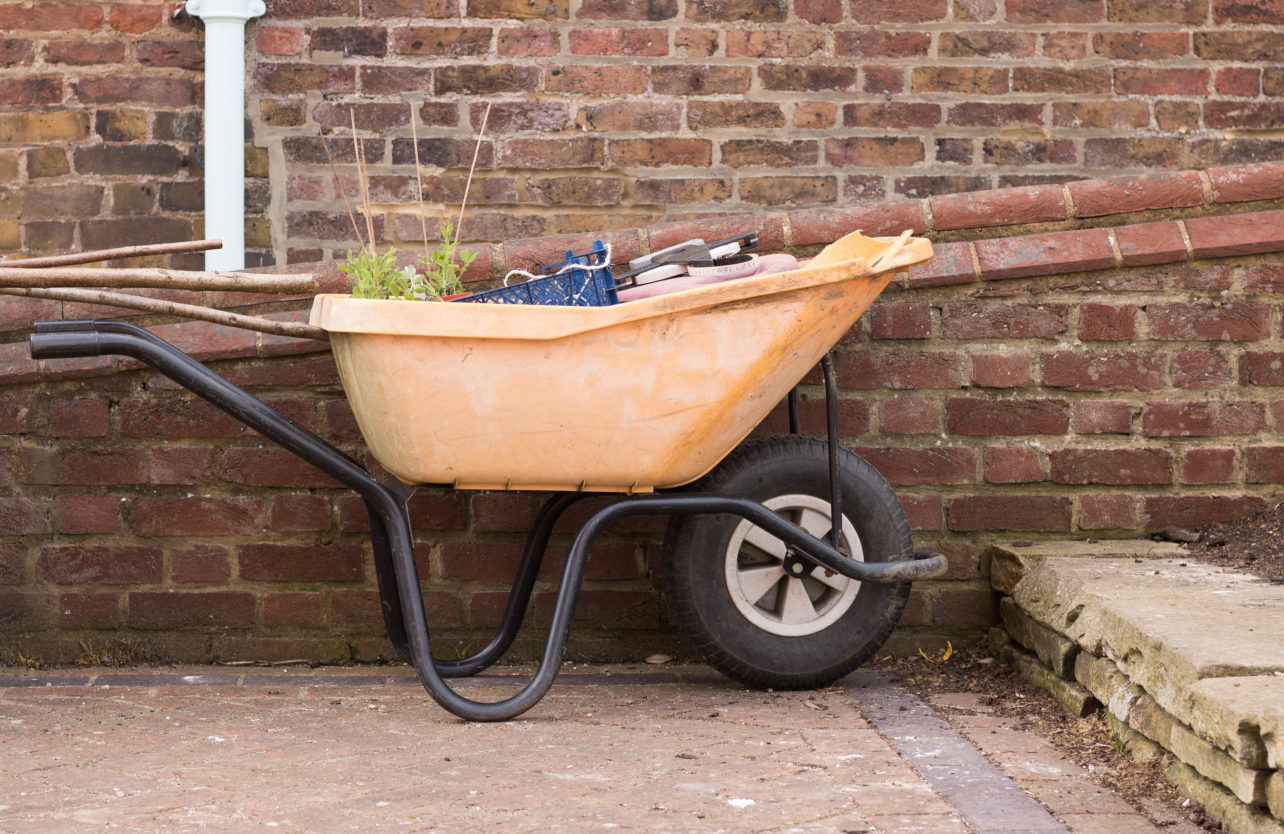Gardening is a great way to stay physically and mentally healthy. Persons who choose to age in place may find comfort in tending to a garden that they have grown and taken care of for years.
Spending some time gardening allows you to enjoy the fresh air while getting some light exercise and seeing the evidence of your labor. Even so, it may become more difficult as you get older. A garden cart or yard cart could help you to do what you love without becoming overexerted by carrying your heavy tools and garden supplies for you.
What is a garden cart?
A garden cart can also be called a yard cart, utility cart, lawn cart, gorilla cart, or dump cart. It is similar to a wheelbarrow with a few differences. There are a few pros and cons of a wheelbarrow vs garden cart. The steel frame sides of a garden cart are straight instead of sloped as they are on a wheelbarrow. Garden carts also have more wheels than a wheelbarrow. Many of them have two wheels, while some could have three or even four wheels. The wheels are often larger, and the cart is designed to be pulled instead of pushed.
Because garden carts have more wheels, they tend to be more stable than wheelbarrows and can hold more weight or larger items. They are ideal for moving stones, wood, garden ornaments, or pots. They can also be used to carry garden tools or plant trays.
Most heavy duty garden carts have a low center of gravity. This gives them greater stability while making it easier to load and offload heavy items and large loads.
Things to consider before purchasing a garden cart.
There is a variety of different types of garden carts on the market. As mentioned above, these carts are often called by different names: yard carts, utility carts, or lawn carts. While they may all look similar, some could have features that are more suited to your needs. Here are a few things to look at when choosing a garden cart that is right for you.
What size garden cart do you need?
When looking for a garden cart, you need to consider the capacity. This could refer to the weight or cubic feet of material it can carry. Smaller garden carts can hold a couple of cubic feet, while larger ones can hold as much as a standard wheelbarrow (6 cubic feet) or more.
Generally, light duty garden carts usually have a weight capacity of up to 200 pounds. This makes them ideal for use around the garden, to move soil, debris, plants, garden tools, potted plants, and compost or mulch. A heavy duty garden cart can hold between 350 and 500 pounds, making them great for transporting bags of cement, larger rocks, or bricks. Larger garden carts like two-wheeled hand trucks could have a load capacity of 750 pounds or more. These are usually used to transport large landscaping features like fountains, large trees, or boulders.
Larger garden carts can carry more things, but this could also make them heavy and difficult to move. Besides this, larger carts could be challenging to maneuver, especially if you are using them in a small space or around areas with tight corners.
The terrain where you will be using your garden cart.
Garden carts, especially those with bigger wheels, generally work better over rough and uneven terrain. On the other hand, they can be challenging to manage when moving down a steep incline.
The type of handle that works better for you.
Garden carts come with different handle configurations. Some carts have two handles, similar to a wheelbarrow, while others have a single handlebar.
Look for handles or a handlebar that are comfortable to hold. Some garden carts have cushioned grips on the handles that make it easier to grip and put less strain on your hands. In general, a handle that is between 1.25 and 1.5 inches in diameter is comfortable enough to give you a good grip without leaving you with tired hands.
The placement of the handle(s) is also important, and some garden carts have an adjustable handle. Handles should be high enough for you to maneuver the cart while standing upright, without lifting the garden cart off the ground. It should also not be too low, forcing you to bend or crouch while you are moving it. There should be enough space for you to move freely while using the garden cart. You should be able to pull the cart along comfortably without kicking it or having it run into the backs of your legs or heels.
Handles should be able to be stored in a safe position when not in use. Some handles fold away or can be lifted up to rest against the cart. Keep in mind that there is a risk that handles stored like this could fall if they are not secured correctly. On the other hand, handles that lay flat on the ground could be a trip hazard, and care should be taken when moving around garden carts with these types of handles.
The materials that the garden cart is made of.
The best garden carts have a bed or tray that is strong and durable enough to hold your gardening supplies. It should also be light weight and easy to move around. Lastly, you may want to consider where you will be storing your garden cart and how much time you would want to dedicate to maintaining it.
Garden carts that are made of metal are robust, but they could rust. These garden carts will require some maintenance to keep them in good condition. Scratches should be sanded and cleaned before being repainted to lengthen the cart’s lifespan.
Sometimes steel framed carts have polycarbonate beds instead of metal beds. Polycarbonate is lighter than metal, does not get scratched or dented as easily, and has a lower risk of being damaged by UV rays.
Wooden garden carts are sturdy; however, they could be prone to rot or become warped if they are in contact with moisture often.
Most garden carts made of plastic can withstand various weather conditions, especially if they are constructed from a thick, high-density polypropylene. This material is often UV-resistant which means they are less likely to become brittle and break or crack when left out in the sun. Plastic garden carts are lightweight and can usually carry up to 200 pounds over easy terrain.
Typically, there are three types of tires on garden carts: pneumatic tires, solid tires, and plastic wheels. Pneumatic tires are filled with air, and carts with these tires are slightly easier to push and less bumpy over uneven terrain. The downside of pneumatic tires is that they can get a puncture and go flat, but they are easy to repair or replace.
Solid tires are filled with rubber or foam, and thus they won’t puncture or need to be inflated. Foam or rubber wheels usually come in larger sizes that make them ideal for rougher surfaces. However, garden carts with solid tires could bounce around more on rough terrain than those with pneumatic tires.
Plastic wheels are usually fitted on light duty garden carts. These wheels work best on smooth surfaces like lawns, cement, or pavement. Plastic tires are durable and require little maintenance, although they could crack or warp in extreme weather conditions.
The wheels should suit the terrain on which you will be using it most while still making it easy to move the cart around. All three types of wheels need to be greased regularly, and pneumatic wheels should be inflated to the recommended pressure. This will make the cart easier to move around and keep the tires in good condition for longer.
How many wheels your garden cart should have.
Part of the appeal of garden carts is that they are more stable than wheelbarrows. They are more stable because they have more wheels. Garden carts with two wheels can be pushed or pulled. They are easy to maneuver because you don’t need to move them (forward or backward) to turn.
Three-wheel garden carts are usually electric. The drive axle that connects the two front wheels of these garden carts is powered and moves the cart forward. The back wheel is in the center and allows you to steer the garden cart.
Four-wheel carts can either be pushed or pulled. They are more cumbersome to move around than two- or three-wheel garden carts, but they are more stable. Pull carts with four wheels have a fixed axle at the back and a steering axle at the front. This steering axle is attached to the handle, and the wheels turn in the direction in which the handle is pulled.
Pushcarts with four wheels have a fixed axle in the back and two wheels that pivot independently of each other in the front. The wheels on these carts turn in the direction in which the front of the cart is being pushed.
Additional features to look for.
Garden carts with brakes or a brake bar work well in gardens that have a gradient. They are also safer to use as a bench when you are ready to take a break.
Many garden carts have a quick-release dump feature like sides that fold down, collapse, or can be removed altogether. Foldable or removable sides make loading and offloading easier. It also allows for easier storage.
While these additional features may not seem necessary, they could make your garden cart more versatile. This could allow you to use them for different projects in a variety of environments.
Why garden carts are helpful for seniors who choose to age in place.
Older adults who have trouble walking or are not as stable on their feet as they used to be may find it easier to pull a garden cart instead of pushing a wheelbarrow or carrying heavy gardening supplies.
Because garden carts are generally lower than wheelbarrows, they could be a better option for seniors who find it challenging to pick up heavy items. Garden carts with foldable, collapsible, or removable sides could also make loading and offloading easier.
Some garden carts are powered by a gas or electric motor. These make gardening convenient for older individuals who want to enjoy gardening without the strain of moving heavy equipment around. The motor drives the wheels that propel the garden cart forward. On some garden carts, the electric motor can also be used to raise the tray or dump bed.
Electric garden carts have rechargeable batteries that can run for around three hours. They vary in speed and how well they handle uneven terrain. Not all electric garden carts have brakes.
Garden carts make gardening more pleasurable and less strenuous for older adults and their in home care providers. They can be used to move heavier items or larger amounts of gardening supplies like compost or mulch. Older adults who enjoy gardening could benefit from using a garden cart to take care of the heavy lifting – while they continue doing what they love as they age in place.




